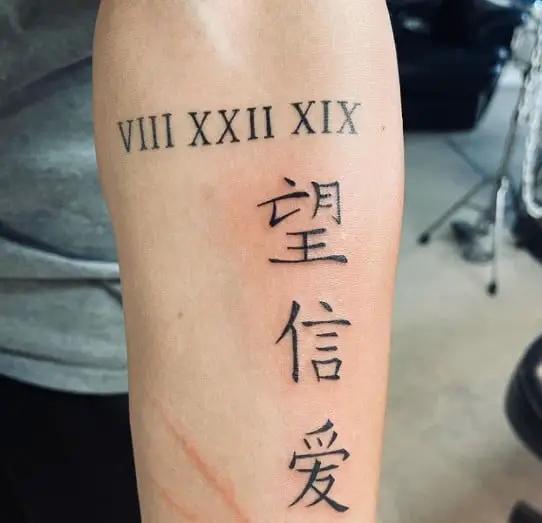The most commonly used Japanese symbol for faith is:
信
It is a Chinese Character which has meanings that encompass faith, truth, fidelity and trust.
Chinese character for faith as a tattoo
Here’s what it looks like if when you make a kanji tattoo using this character:


Check here, If you’re interested to see what we consider to be cool kanji tattoos and bad kanji tattoos.
How is the Japanese symbol for faith used in Japan?
The character 信 is not used commonly in Japan in isolation. To mean faith, it is usually combined with the character 仰 to make the word “信仰 shinkou”, the word closest in Japanese to the English word “Faith”.
The Japanese symbol for faith also gets used in the Japanese verb 信じる (Shinjiru) meaning to believe; to place trust in; to confide in; to have faith in.
Other words the character are used in include:
信頼 (shinrai)
reliance; trust; faith; confidence
信託 (shintaku)
trust; entrusting
信用 (shinyou)
confidence; dependence; credit; faith; reliance; belief; credence; trust
自信 (jishin)
Confidence, self-belief

Japanese symbol for faith stroke order
The order in which Kanji Chinese characters are written in Japan are considered very important. The Japanese symbol for faith is written as illustrated below:
Breaking down the different parts of the Japanese symbol for faith
Interestingly, the radicals, or parts that make up the character mean “Human” 人 and “patience/endurance” 言. So on the simplest level, the character gives the sense of a “patient person”.
The right side of the Chinese character can be broken down further. “言” is essentially a pictograph, combining the radical of “口 mouth” placed under an altered form of the radical “辛 difficult”.
So what is the symbology telling us in this Kanji (Chinese character)?
The connection between the Japanese symbol for faith and tattoos
Funnily enough for those that are thinking about getting a tattoo of the Kanji for faith, there is actually a reference to tattoos in the history of the character itself.
The word “辛 difficult” can also refer to a tattoo needle. It is used here in the sense of a tattoo being engraved on a person as a form of punishment.
The “口 mouth” below it is a square box called “sai”. It represents a vessel, or box, which was used for putting prayers into. A kind of “prayer box”.
The Chinese character “言”, which is a combination of these two characters, has the meaning of an oath with God. Literally it means, “If I break my promise, may I receive a permanent tattoo as punishment”.
Other Chinese characters that “faith” is often combined with
The kanji for faith is often placed next to other Chinese or Japanese letters for things most people consider virtuous. Here are two examples of it being placed next to characters for 望 (hope) and 愛 (love). The first one is written using the Japanese form of the characters and the later one using the Chinese form.
Remember that if you chose to put kanji together that people will naturally make an attempt to read them as several letters making up one word. This can be confusing and sometimes off-putting. You might want to consider placing some kind of visual separation between them.


Is the Japanese symbol for Faith exactly the same as the English word “faith”?
As always, it is best to be aware that words in different languages are never strict “equivalents”. Language is closely bound up with culture, history, religious ideas etc. So translations of words are better thought of as “approximations”. To look at what is meant by the word “faith” we need to look at the word a little more closely.
What is Faith?
Faith in a sense is a deep and abiding trust or confidence in someone or something, a belief in the principles of a religion, the truth of a statement. In Christianity, faith is also often used to translate the Greek word pistis. The word translated as “faith” can also be translated as “believing.” In other words, to have faith in something means that one has confidence that it will happen.
In Judaism, there are three levels of faith: 1) Emunah (strong belief), 2) Bitachon (trust), and 3) Emet (truth).
In Islam there are two types of faith: 1) Iman which means deep acceptance and conviction in Allah and His Messenger Muhammad; 2) Ihsan which means doing deeds consistent
The Role of Faith in Japan
Faith in Japan is oftentimes associated with the traditional religions of Buddhism and Shintoism, but there are also significant numbers of Christians and other types of people who believe in some form of religion.
Japanese people, for the most part, believe that spirit, or spirits, exist in all things. So natural objects including trees, mountains and rocks are generally considered to have a “spirit” or be the physical manifestation of a god.
In this context the word “faith” obviously has a different set of nuances and deeper meaning than it does in a Judeo-Christian society.
